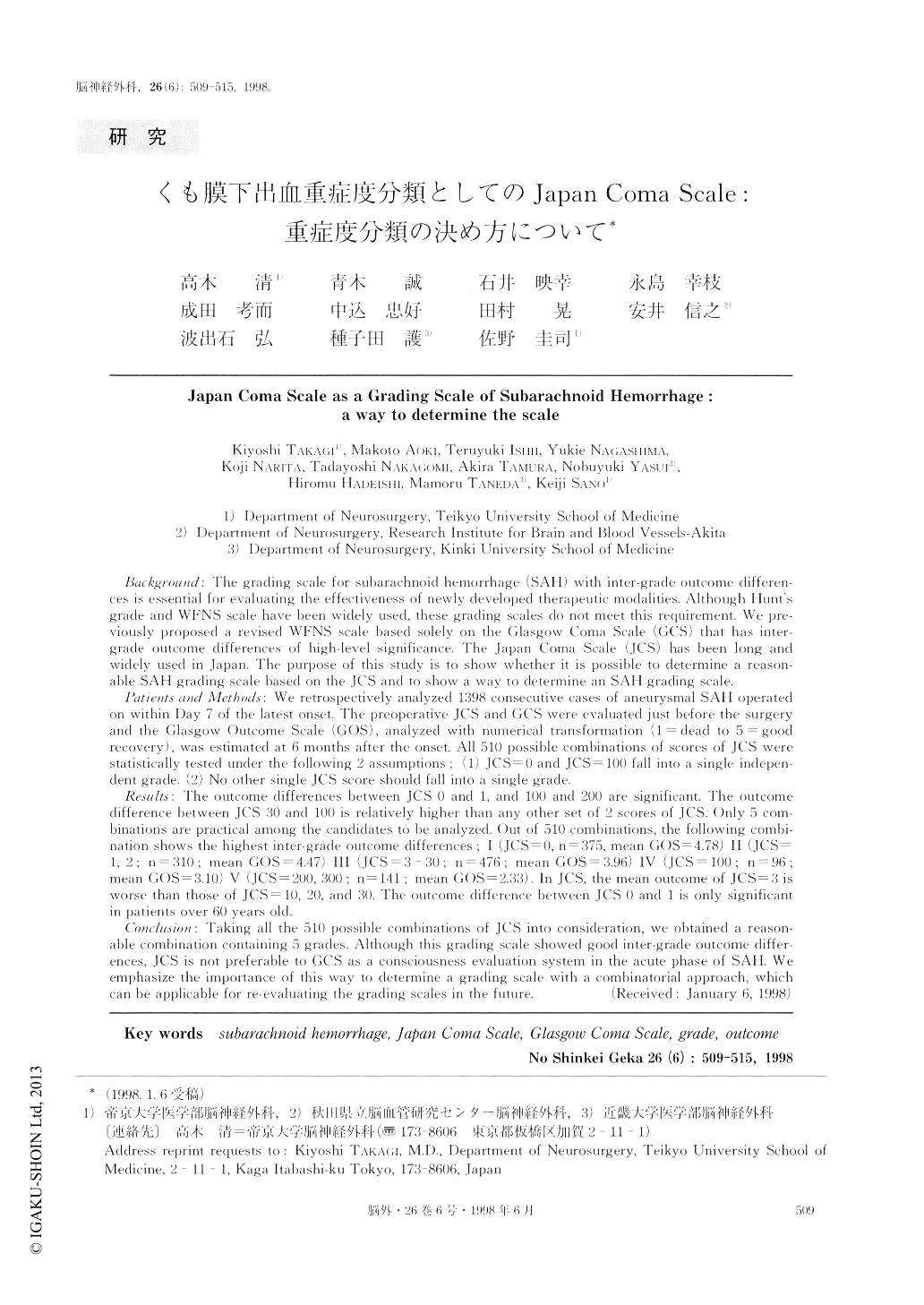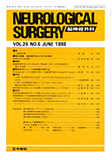Japanese
English
- 有料閲覧
- Abstract 文献概要
- 1ページ目 Look Inside
I.はじめに
脳動脈瘤破裂によるくも膜下出(SAH)の重症度を評価する主な目的は,予後を予測して手術適応の有無を判断することにある.手術後の予後を改善する目的で,カルシウム拮抗薬,clot re-moval,induced hypertensionなど様々な治療が試みられ1,5,9,11,16,19,22,24),SAHの予後は確実に改善してきているが,1980年以降はplateauに達している21).
SAHの予後をさらに向上させるために現在も新しい試みがなされているが,限られた数の症例から治療効果を正しく評価するためには症例群を重症度別に階層化することが重要である.その前提として重症度分類の各grade間で予後に差があることが絶対的な必要条件であるが,これまで提唱されてきた多くの重症度分類2,7,8,15,23).にはいくつかの不備が指摘されている.その主な点はgradeが異なるのに予後に差が認められない部分があることと4,6),同じ症例が評価者によって異なったgradeに分類されるという2点である13,14).この2点は,grading scaleの目的を考えたとき致命的な欠陥である.
Background: The grading scale for subarachnoid hemorrhage (SAD) with inter-grade outcome differen-ces is essential for evaluating the effectiveness of newly developed therapeutic modalities. Although Hunt'sgrade and WFNS scale have been widely used, these grading scales do not meet this requirement. We pre-viously proposed a revised WFNS scale based solely on the Glasgow Coma Scale (GCS) that has inter-grade outcome differences of high-level significance. The Japan Coma Scale (ICS) has been long andwidely used in Japan. The purpose of this study is to show whether it is possible to determine a reason-able SAH grading scale based on the JCS and to show a way to determine an SAH grading scale.
Patients and Methods: We retrospectively analyzed 1398 consecutive cases of aneurysmal SAH operatedon within Day 7 of the latest onset. The preoperative JCS and GCS were evaluated just before the surgeryand the Glasgow Outcome Scale (GOS), analyzed with numerical transformation (1=dead to 5=goodrecovery), was estimated at 6 months after the onset. All 510 possible combinations of scores of JCS werestatistically tested under the following 2 assumptions; (1) JCS=0 and JCS=100 fall into a single indepen-dent grade. (2) No other single JCS score should fall into a single grade.
Results: The outcome differences between JCS 0 and 1, and 100 and 200 are significant. The outcomedifference between JCS 30 and 100 is relatively higher than any other set of 2 scores of JCS. Only 5 com-binations are practical among the candidates to be analyzed. Out of 510 combinations, the following conthi-nation shows the highest inter-grade outcome differences; I (JCS=0, n=375, mean GOS=4.78) II (JCS=1, 2;n=310 mean GOS=4.17) III (JCS=3-30 n=476; mean GOS=3.96) IV (JCS=100 n=96;mean GOS=3.10) V (JCS=200, 300; n=141;mean GOS=2.33). In JCS, the mean outcome of JCS=3 isworse than those of JCS=10, 20, and 30. The outcome difference between JCS 0 and 1 is only significantin patients over 60 years old.
Conclusion: Taking all the 510 possible combinations of JCS into consideration, we obtained a reason-able combination containing 5 grades. Although this grading scale showed good inter-grade outcome differ-ences, JCS is not preferable to GCS as a consciousness evaluation system in the acute phase of SAH Weemphasize the importance of this way to determine a grading scale with a combinatorial approach, whichcan he applicable for re-evaluating the grading scales in the future.

Copyright © 1998, Igaku-Shoin Ltd. All rights reserved.


